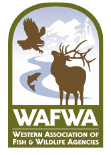
FOR IMMEDIATE RELEASE
March 8, 2016
Contact: Bill Van Pelt, (602) 717-5066, bill.vanpelt@wafwa.org
Aerial
Surveys to Document Lesser Prairie-Chicken Population Trends
Aerial
surveys for lesser prairie-chickens will begin March 17 and run through
mid-May in five states containing habitat the bird needs to thrive. The
surveys are conducted annually by the Western Association of Fish and
Wildlife Agencies (WAFWA) to ascertain population trends and how the bird
is responding to management strategies identified in the Lesser
Prairie-Chicken Range-wide Conservation Plan.
The range-wide plan is a
collaborative effort of WAFWA and the state wildlife agencies of Texas, New
Mexico, Oklahoma, Kansas and Colorado. It was developed to ensure
conservation of the lesser prairie-chicken with voluntary cooperation of
landowners and industry. This plan allows agriculture producers and
industry to continue operations while reducing impacts to the bird and its
grassland habitat.
“Working with the wildlife
agencies of each of these five states, we’ve established a consistent
methodology to conduct these aerial surveys,” explained Bill Van Pelt,
WAFWA’s grassland coordinator. “This allows us to get the most accurate
information possible so we can see how various management strategies for
the bird are working on the ground.”
The surveys will be conducted
by helicopter in locations chosen randomly within lesser prairie-chicken
range, which is part of the methodology strategy. In previous years, some
of the fly paths prompted calls, which is why WAFWA is getting the word out
about the start of aerial survey work.
Last year’s aerial surveys
brought good news: an abundance of spring rainfall in 2015, along with
ongoing efforts associated with the range-wide plan and other conservation
initiatives, helped increase the lesser prairie-chicken population by
approximately 25 percent from 2014 to 2015. Results from this year’s
surveys will be available on July 1. Despite last year’s encouraging news,
the population is still low compared to historical numbers, and the impacts
to the lesser prairie-chicken and its habitat still exist. WAFWA is
committed to continued successful implementation of the range-wide plan and
the long-term recovery of this iconic grassland bird.
Since 1922, the Western Association of Fish and Wildlife Agencies
(WAFWA) has advanced conservation in western North America.
Representing 23 western states and Canadian provinces, WAFWA’s reach
encompasses more than forty percent of North America, including two-thirds
of the United States. Drawing on the knowledge of scientists across the
West, WAFWA is recognized as the expert source for information and analysis
about western wildlife. WAFWA supports sound resource management and
building partnerships at all levels to conserve native wildlife for the use
and benefit of all citizens, now and in the future.
####
|
No comments:
Post a Comment